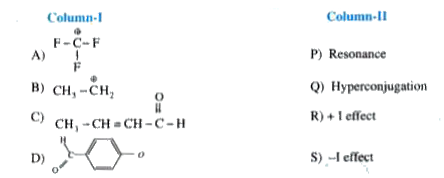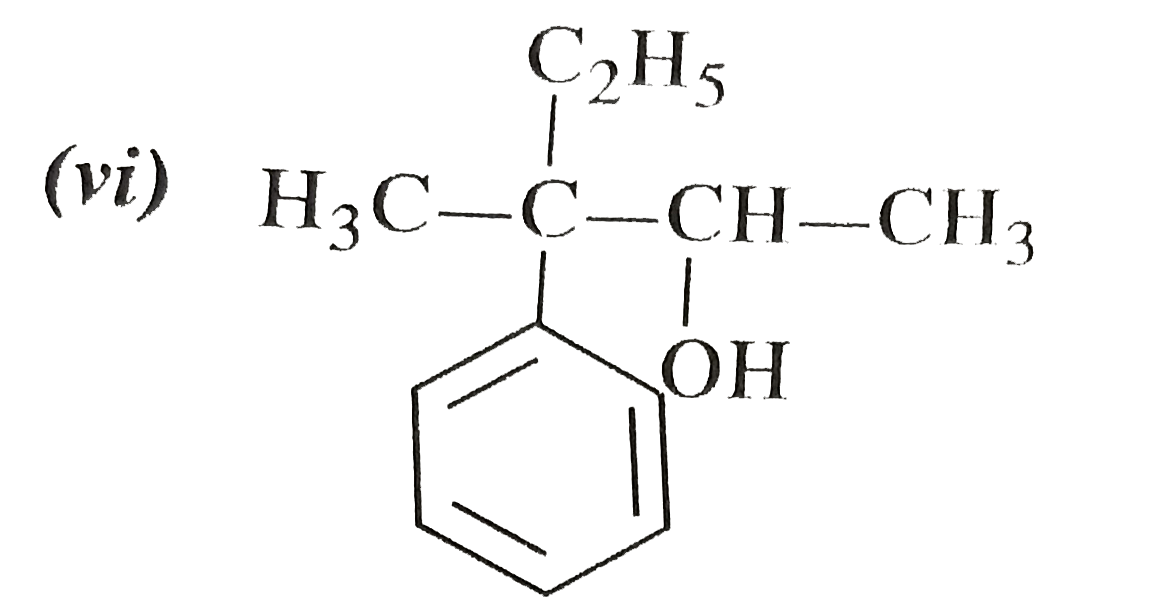In how many of the following the concept of resonance can be observed
Solution in Telugu
The correct Answer is:4
Step by step video, text & image solution for In how many of the following the concept of resonance can be observed CH_(2)=CH-Cl, CH_(3)-O-overset(+)(C)H-CH_(3) CH_(3)-O-CH_(2)overset(+)(C)H, CH_(3)-NH-CH_(2)-CH-CH_(3) CH_(3)-CH=CH-NH_(2), CH_(3)-CH_(2)=CH_NH-CH_(3) by Chemistry experts to help you in doubts & scoring excellent marks in Class 11 exams.
Updated on:21/07/2023Topper's Solved these Questions
- ELECTRONIC EFFECTS AND REACTION INTERMEDIATESBOOK - AAKASH SERIESCHAPTER - ELECTRONIC EFFECTS AND REACTION INTERMEDIATESEXERCISE - PRACTICE SHEET - EXERCISE-II (Staight Objective Type Questions)
10 Videos
- ELECTRONIC EFFECTS AND REACTION INTERMEDIATESBOOK - AAKASH SERIESCHAPTER - ELECTRONIC EFFECTS AND REACTION INTERMEDIATESEXERCISE - PRACTICE SHEET - EXERCISE-II (LEVEL - II Straight Objective Type Questions)
9 Videos
- ELECTRONIC EFFECTS AND REACTION INTERMEDIATESBOOK - AAKASH SERIESCHAPTER - ELECTRONIC EFFECTS AND REACTION INTERMEDIATESEXERCISE - PRACTICE SHEET - EXERCISE-I (LEVEL-II Matrix Matching Type Questions)
2 Videos
- ELECTRON MIGRATION EFFECTS BOOK - AAKASH SERIESCHAPTER - ELECTRON MIGRATION EFFECTS EXERCISE - QUESTIONS FOR DESCRIPTIVE ANSWERS
10 Videos
- ELEMENTS OF BORON FAMILYBOOK - AAKASH SERIESCHAPTER - ELEMENTS OF BORON FAMILYEXERCISE - OBJECTIVE EXERCISE - 3
7 Videos
Similar Questions
What are electrophiles ? Explain with two examples
View SolutionWhich one of the following is the most stable alkene?
View SolutionMatch the following columns

View SolutionHyperconjugation effect is also termed as 'no bond resonance'. Why?
View SolutionWhich one of the following compounds is not a protonic acid ?
View SolutionGiven the IUPAC names of the following compounds: (i) CH_(3)CH_(2)CH_(2)underset(C_(2)H_(5))underset(|)overset(CH_(3))underset(|)(C )CH_(2)-overset(CH_(3))overset(|)(C )=CH_(2) (ii) CH_(3)-overset(CH_(3))overset(C )H-C-=CH (iii) C_(6)H_(5)-CH=CH-CH_(2)Cl CH_(3)CH-CH-CH_(2)Cl (iv) CH_(3)CH=CH-CH_(2)Br v CH_(2)=CH-overset(Cl)overset(|)(C )-CH=CH_(2) vi CH_(2)=CH-overset(CH_(2)CH_(3))underset(|)(C )H-underset(Cl)underset(|)(C )=CH_(2) vii. (CH_(3))_(3)C - CH=CH_(2)
View SolutionWrite the IUPAc name of the following compound :
(a) CH3−CH2−CH3∣CH−CH=CH−CH2−CH3
(b) CH3−CH2−CH3∣CH−CH2−CH3∣CH−CH∣CH2∣CH2∣CH−CH3∣CH3−CH=CH3∣C−CH3
View SolutionCH_(3)CH_(2)CH_(2)-overset(O)overset(||)(C)-H+CH_(3)-C-=CH overset(Na,NH_(3)(l))to
View SolutionCH_(3)-underset(CH_(3))underset(|)(CH)-CH=CH-CH_(2)-overset(O)overset(||)(C)-OH
View SolutionRated of additon of CI2/H2O of the following alkene are:
CH=CH2 CH2=CH−O∣∣C−H CH3−CH2−CH=CH2 CH3−CH3∣C=CH2
View SolutionGive the IUPAC names of the following :
(i) CH3−CH=CH−CH=CH2
(ii) CH3−CH2−CHO
(iii) CH−O∣∣C−CH2−CH3
View SolutionGive the IUPAC names of the following compounds:
(i)C6H5−CH2−CH2−OH (ii)CH3−CH3∣C∣CH3−CH2−CH2−OH
(iii)[(CH3)2CH]3COH. (iv)CH3−CH∣OH−CH2−CH2−O−CH2CH3
(v)CH3−CH2−CH∣Cl−CH∣CH3−CH3∣C∣OH−CH3 (vi)
(vii)(CH3)3COH (viii)CH3−CH∣CH3−CH∣OH−CH2−CH∣CH3−CH3
(ix) CH2OH |CH2−CH2−CH−CH−CH−CH3 | | CH2Cl CH3, (x) CH3−C=C−CH2OH | | CH3Br
(xi) CH2=CH−CH∣OH−CH2−CH3, (xii) CH2OH |CH3−CH−CH2−CH−CH−CH3 | | CH3 OH
View SolutionWhich is the most suitable reagent for the following transformation ?
CH3−CH=CH−CH2−OH∣CH−CH3→CH3−CH=CH−CH2CO2H
View SolutionCH3−CH3∣CH−CH3∣CH−CH(CH2CH2CH3)2
View SolutionWrite the IUPAC names of the following compounds: (i) (C_(2)H_(5))_(2)CH-CH=CH_(2) (ii) CH_(2)=CH-overset(C_(2)H_(5))overset(|)(C)H-CH_(2)-C-=CH (iii) CH_(2)=underset(C(CH_(3))_(2))underset(|)(C)-CH_(2)-CH_(3) (iv) CH_(3)-CH=CH-C-=CH (v) CH_(2)=CH-overset(CH_(3))overset(|)(C)H-CH_(2)-CH=CH_(2) (vi) CH_(3)CH_(2)C-=underset(H_(2)C=CH)underset(|)(C CH)-CH_(2)CH(CH_(3))_(2) (vii) CH_(3)CH_(2)CH_(2)overset(CH=CH_(2))overset(|)(C)HCH_(2)CH_(2)CH_(2)CH_(3) (viii) CH_(2)=CH-overset(CH_(3))overset(|)(C)H-overset(CH_(2))overset(||)(C)-CH_(2)-C-=CH (ix) HC-=C-C=CH-CH=CH_(2) (x) CH_(2)=C=CH-CH_(2)-underset(CH=CH_(2))underset(|)(C)H-CH_(3)
View Solution
